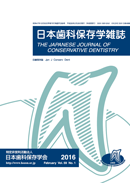Volume 59, Issue 6
Displaying 1-9 of 9 articles from this issue
- |<
- <
- 1
- >
- >|
Mini Reviews
-
2016 Volume 59 Issue 6 Pages 455-457
Published: 2016
Released on J-STAGE: January 06, 2017
Download PDF (855K) -
2016 Volume 59 Issue 6 Pages 458-462
Published: 2016
Released on J-STAGE: January 06, 2017
Download PDF (2854K)
Original Articles
-
2016 Volume 59 Issue 6 Pages 463-471
Published: 2016
Released on J-STAGE: January 06, 2017
Download PDF (9654K) -
2016 Volume 59 Issue 6 Pages 472-478
Published: 2016
Released on J-STAGE: January 06, 2017
Download PDF (348K) -
2016 Volume 59 Issue 6 Pages 479-488
Published: 2016
Released on J-STAGE: January 06, 2017
Download PDF (6270K) -
2016 Volume 59 Issue 6 Pages 489-496
Published: 2016
Released on J-STAGE: January 06, 2017
Download PDF (3813K) -
2016 Volume 59 Issue 6 Pages 497-508
Published: 2016
Released on J-STAGE: January 06, 2017
Download PDF (700K) -
2016 Volume 59 Issue 6 Pages 509-515
Published: 2016
Released on J-STAGE: January 06, 2017
Download PDF (749K)
Erratum
-
2016 Volume 59 Issue 6 Pages 534
Published: 2016
Released on J-STAGE: January 06, 2017
Download PDF (79K)
- |<
- <
- 1
- >
- >|
